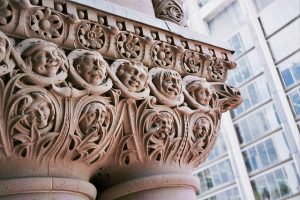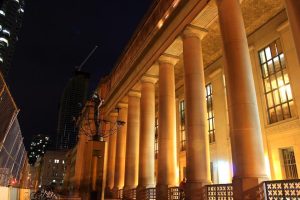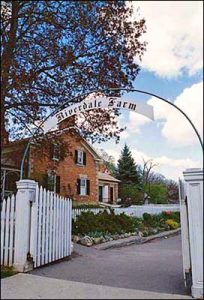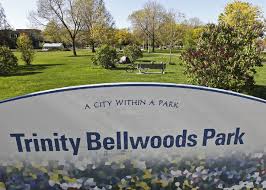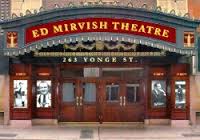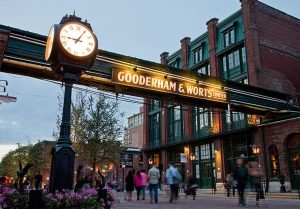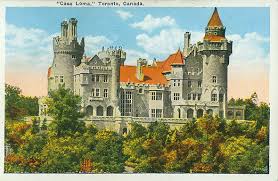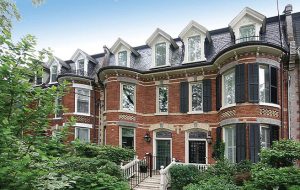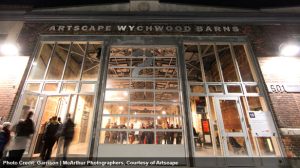10 Best Historic Places in Toronto!
1) Old City Hall and it’s Gargoyles
When Old City Hall opened in 1899, it contained two large (5 feet high) gargoyles, located at the foot of the main staircase. These elaborate pieces of wrought iron, each in the form of a mythical beast, were produced by the Toronto Fence and Ornamental Iron Works.
The gargoyles remained in place at Old City Hall until 1947 until they were removed during renovations for the installation of the war memorial. The poor gargoyles remained unclaimed and unwanted, until Henry Dobson Antiques Ltd., purchased them.
In an effort to return the works to the Toronto public domain, the Metropolitan Corporation bought the grotesques in the late 1980s. In commemoration of Old City Hall’s 100th anniversary, the gargoyles have been restored and have reclaimed their rightful places.
2) Union Station and it’s Name
At the turn of the century, plans got under way our current Union Station(Predesessed by two prior Union Stations, the first built in 1858 west of York St. and a larger station completed in 1873) along a stretch of Front Street that had been razed by the Great Fire of 1904. After years of delays, the Beaux-Arts landmark with its cathedral-like passenger hall finally opened to the public on Aug. 11, 1927.
The Union Station of today is undergoing a gigantic and very costly revitalization/renovation project set to maintain and preserve it’s many storied original features including it’s marble floors and brass door fittings.
Yet, one particular city counsellor wants to change it’s long held name from Union Station to Sir John A. MacDonald Station arguing that there are dozens of “union stations” across North America including in Chicago and Washington.
While we don’t know the outcome of this strange petition, and with all due respect to Sir John A, it just seems a bit odd that on one hand this glorious building’s historical features are being painstakingly restored and saved only to change the name.
3) Riverdale Farm and It’s Old Zoo Ruins
In 1894, the Riverdale Zoo opened to become Toronto’s first zoo, but eventually it was closed in 1974 with the animals relocated to the new Toronto Zoo in Scarborough. From 1974 to 1978, many of the Riverdale Zoo buildings were removed and the site levelled. Now known as Riverdale Farm, the 7.5 acre scenic site is a park setting with ponds, gardens, wooded areas and farm animals all in the heart of the downtown community of Cabbagetown.
Three buildings remain from the old Riverdale Zoo. Donnybrook Ruin beside the cow paddock was originally a two-storey building and a tower and a main floor still remain today. Island House sits in the middle of the lower pond. It housed many different kinds of birds and animals during the eighty years of the zoo. Resident Zookeeper’s House was built in 1902 by prisoners of the Toronto Don Jail and functioned as a residence, a staff building, zoo hospital, and temporary morgue for the Necropolis Cemetery. Today, the “Residence” (as it is now called) is used for a variety of farm-related and community-based programs.
4) Trinity Bellwoods Park and It’s Famous White Squirrel
The white squirrel of Trinity Bellwoods Park is so popular that on Trip Advisor there’s a post called “Spot the White Squirrel” !
Stretching north from Queen St. W. all the way to Dundas St. W. and known to be in the “cool” part of Toronto, this vast park comprises of all types of terrain – flats, hills, and valleys which all makes sense considering that most of the park’s area lies in the original Garrison Creek ravine and this creek, buried in the 1950’s is now a buried city storm sewer and still flows beneath the park from the northwest to the southeast corners.
The steep drop from this upper level to the lower part of the park has become a popular local toboggan run in winter. Picnic tables and small barbecues are also provided here for summertime use, and public washroom facilities. There’s even an old boxing ring in the centre of the valley.
Trinity Bellwoods is a favourite hangout for local hipsters, young families, skateboarders, tightrope walkers and area residents out walking their dogs. The ravine, known as the dog bowl, is the designated leash-free area and was used in the film “Dog Park”
But the most important resident is of course the famous white squirrel who really does exist. There can be two versions of a white squirrel; an albino eastern grey squirrel or a white morph which according to biologists, is the name given to a local variety of a particular species that appears different from the norm. Toronto’s black squirrels, for example, are a black morph of the eastern grey squirrel.
An albino white squirrel has ruby red eyes with a complete lack of pigmentation while a white version of an eastern grey squirrel while white, isn’t an albino.
In any case, the white squirrels have been the mascot for Trinity Bellwoods Park. I’ve yet to see one but I’m keeping my brown eyes wide open!
The arts and culture scene has always been alive in Toronto and it is home to many historic theatres. At 94 years old, the Ed Mirvish Theatre was the largest and most elegant theatre in Canada when it opened in 1920.
The Pantages Theatre, as it was called then, was originally a combination vaudeville, burlesque and motion picture house. The Pantages empire grown over 30 years came to a sudden end in 1929 when it’s owner, Alexander Pantages was convicted of the rape of a 17-year-old chorus girl and sentenced to 50 years in prison. Although the conviction was overturned on appeal, the scandal and the legal costs ruined Pantages. In 1930 he was forced to sell his theatres – at pennies on the dollar – with most of his assets going to RKO Pictures.
It later became the Imperial Theatre, then the Canon Theatre and was finally renamed the Ed Mirvish Theatre in 2011 after iconic Toronto businessman and theatre impressario Ed Mirvish.
Over the years it has seen some major productions including The Phantom of the Opera, Les Miserables, Cats and Wicked. Everything from the ornate marquee outside to the grand staircase in the lobby will make you feel like you’re back in 1920’s Toronto. The Ed Mirvish Theatre was listed on the City of Toronto Heritage Property Inventory in 1979.
6) The Distillery District and it’s Rich Whisky Heritage
The Distillery District is an area which was established in 1832 by Gooderham and Worts. The distillery aimed to convert the surplus of grain into whiskey; the area had the largest stone distillery in Canada from 1851 to 1861. Once one of the largest distilleries in the world, it produced over 2 million gallons a year and helped established Toronto as a manufacturing mecca, with a brick malt house, kilns, warehouses, shops and offices all built before 1900.
After a huge revitalization project, the area is now a lively entertainment district — full of fine restaurants, cafés, and specialty shops. Artist studios and other creative companies now occupy the upper floors of the historic brick buildings. Set against this Victorian backdrop are glistening new condo buildings which have turned the area into a much desired place to live and work.
7) Allan Gardens and “The Palm House”
This five-acre parcel of land was donated to the City of Toronto in 1858 by George Allan who was a prominent politician and cultural leader of the time. Allan Gardens is one of Toronto’s oldest parks and has one of the most stunning conservatories known as The Palm House which sits smack dab in the middle of the park.
This gorgeous Victorian-style conservatory “Palm House” was built by architect Robert McCallum in 1910, and it features a cast-iron and glass dome and is designated under the Ontario Heritage Act. On fine days, it glitters in the sun, resembling a fine-cut gem set in the green grounds. The building design emphasizes the use of repetition, symmetry, and contrast in its fine details.
Allan Gardens is wildly popular and attracts both locals and tourists who delight in visiting the park all year around. Housed in a series of greenhouses live all sorts of exotic plants and flowers – including cacti and other succulents, rare tropical orchids and citrus trees.
8) Casa Loma and it’s Secret Passageways
One of the major tourist attractions in Toronto, this beautiful Gothic Revival castle majestically sits atop Spadina Hill Road.
Just over a century old, Casa Loma (“house on the hill” in Spanish) was built by Sir Henry Pallat who is said to have built this Medieval like castle to remind him of his beloved Irish homeland. The architect responsible for Casa Loma’s unmatched European elegance and splendour was E.J. Lennox, who also worked on many other famous buildings in Toronto, such as Toronto City Hall, the Toronto Athletic Club, and Maurice Cody Hall.
The interior includes secret passageways, an 800-foot tunnel, breathtaking towers, a grand staircase, and stunning original furnishings. The castle gardens spread out on five acres and feature a Secret Garden and former stables constructed of mahogany with floors covered in Spanish tiles. The castle is often featured in Hollywood blockbusters such as X-men, Chicago, Extreme Measures and Scott Pilgrim vs. the World.
Casa Loma is a place to go back in time and is a wonderful backdrop for lavish weddings, classic afternoon tea parties and leisurely garden strolls.
9) Cabbagetown and it’s Treasured Victorian Houses
One of the most gentrified and complete Victorian “villages” anywhere, Cabbagetown is said to be the largest continuous area of preserved Victorian housing in all of North America. Contained within it’s boundaries are 2 old cemeteries, a farm, a large park, a main commercial strip and many streets and lanes lined with Victorian housing predominantly in the style of Toronto Bay-and-Gable, Second Empire, and Queen Anne.
First known as the village of Don Vale, Cabbagetown is located just to the east of the downtown core. It’s name derives from the working class Irish immigrants who moved to the neighbourhood beginning in the late 1840s, said to have been so poor that they grew cabbage in their front yards. Brick Victorian style houses were built throughout the area at that time through to just before WW1.
After the war the area became increasingly impoverished and was considered one of Toronto’s largest slums. Much of the original Cabbagetown was razed in the late 1940s to make room for the Regent Park housing project. The remaining section to the north, then still known as Don Vale, was also slated to be cleared and replaced by housing projects but was halted in the 70’s with the rise of the reform movement which opposed these plans and with this, the gentrification process began. It was from then onward, that affluent professionals began to lovingly restore many of the beautiful and unique Victorian homes.
Cabbagetown is today one of the most affluent and sought after areas in Toronto with gourmet food shops, upscale boutiques, art festivals, and wine tasting events held annually while paradoxically, it also has the largest concentration of homeless shelters, group homes and rooming houses.
10) Wychwood Barns and it’s Artist’s Studios
Wychwood Barns is a community centre and park in the Hillcrest/Bracondale Hill area of Toronto. The converted heritage complex consisted of 5 buildings on 4.3 acres and was built on land expropriated by the City of Toronto for use by the Toronto Civic Railways (later known as the TTC) in 1913. It was used as a streetcar maintenance facility from when it was built until 1992 when it’s use became redundant with the proximity of the Hillcrest Facility.
In 1996 it was transferred to city ownership for a nominal $1 fee. The City of Toronto currently leases the site to Toronto Artscape Inc., a not-for-profit organization that develops and operates space for the arts, at $1 a year for 50 years. Artscape Inc. redeveloped the site and it was officially opened in November of 2008.
It is now a multipurpose space and contains artist housing and studios, a public green space, a dog park, a greenhouse, a farmers market and a beach volleyball court. It holds numerous events throughout the year and has offices which serve many local community organizations.


